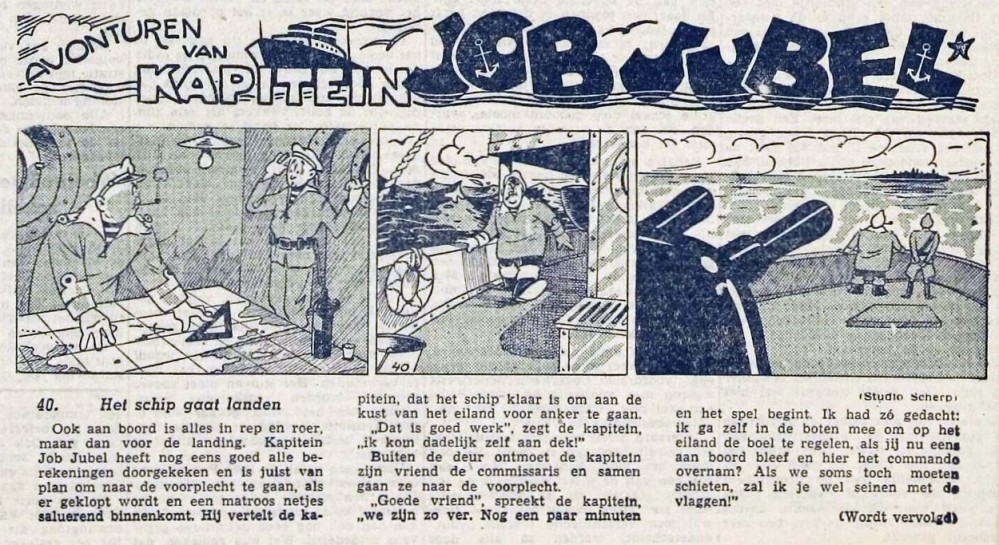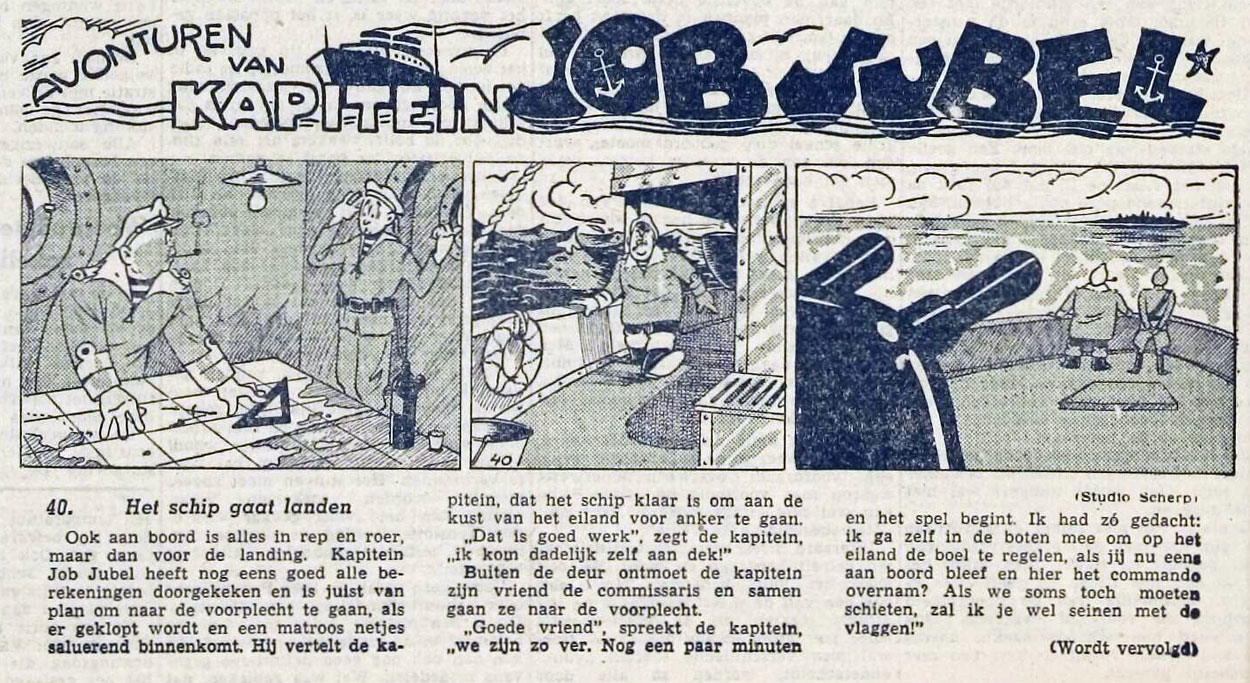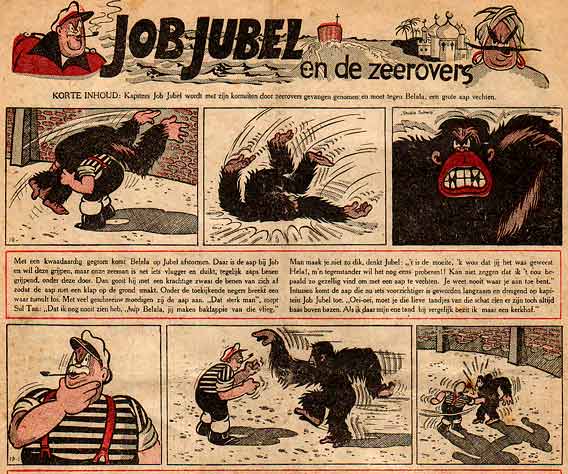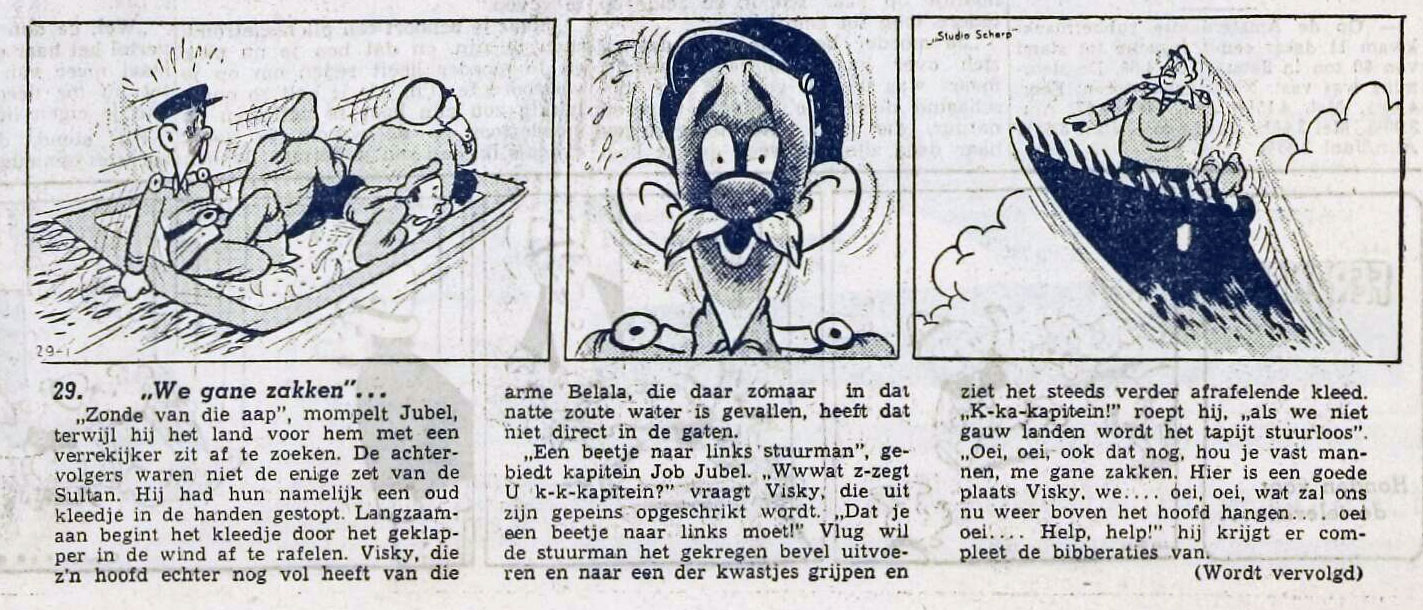'De Avonturen van Kapitein Job Jubel' (Nieuwe Leidsche Courant, 22 February 1951).
Peter Scherpenisse was a Dutch advertising artist, designer and cartoonist, who ran the Voorburg-based graphic art firm Studio Scherp in the second half of the 20th century. He created the naval comic strip 'Job Jubel' (1949), which ran in the children's magazine Okidoki and was later reprinted in the local newspaper Nieuwe Leidsche Courant (1950-1951).
Early life and career
Pieter Ary Scherpenisse was born in 1927 in The Hague, and got his artistic education at the Art Academy. In the years before World War II, his father had started Studio Scherp, a graphic art firm specialized in advertisements. As a youngster, Peter helped his father in the studio, until it ran out of work during the war years. After the Liberation (1944-1945), Peter Scherpenisse took over Studio Scherp, specializing in lettering for cars and vans, which he applied with a brush.
Job Jubel
During the 1940s, Peter Scherpenisse also tried his hand at cartooning, initially trying in vain to sell his artwork to newspapers. By 1949, the children's magazine Okidoki ran his first and only known comic strip, 'Job Jubel en de Zeerovers', credited to Studio Scherp. At the start of the story, the sea captain Job Jubel is resting from a dangerous sea journey, until he is triggered by a newspaper article about a ship without cabins, funnels and sails, seen in the Gulf of Pitogiri. Suspecting it to be the cause of several missing ships in the area, the captain decides to go for the government reward money and recover the mysterious ship. Another epic sea journey follows, during which Job Jubel, along with his sailors Visky, Leepie and Loos, endure an attack from tribal privateers, an evil Sultan, an arena fight with a big ape and several other dangers.
Like most Dutch comics at the time, 'Job Jubel' was presented as a text comic, with text printed beneath the images. The Dutch post-war period was a particularly rich time for nautical comics, around the same time both Pieter Kuhn's 'Kapitein Rob' (1945-1972) and Marten Toonder's 'Kappie' (1945-1972) were launched. Between 9 September 1950 and 6 March 1951, 'Job Jubel en de Zeerovers' was reprinted under the title 'De Avonturen van Kapitein Job Jubel' in 50 daily episodes in the local newspaper Nieuwe Leidsche Courant.
'Job Jubel en de Zeerovers' in Okidoki magazine.
Studio Scherp
After starting a family - his wife Elly and he had two daughters and one son - Peter Scherpenisse continued Studio Scherp in the town of Voorburg, setting up shop on the ground floor of a mansion. From the 1950s on, the firm designed advertisements, neon signs, car lettering and banners. In 1979, his son Olaf also joined the studio, and eventually took over the company after Peter Scherpenisse's retirement in 1992.
Under the management of Olaf Scherpenisse and his wife Leny, Studio Scherp was modernized. Gradually replacing the old-fashioned craftwork, the couple invested in large format printers and other machinery. As the company moved to larger workspaces in Leiden (in 1989) and then Zoeterwoude (in 1999), Studio Scherp expanded from a small-scale lettering studio into an allround advertising agency. When in October 2023, Olaf and Leny Scherpenisse retired as well, they sold their firm to another advertising company, which also took over the entire Studio Scherp staff.
Final years and death
In the final years of his life, Peter A. Scherpenisse took up fine art painting in various styles. He also wrote down his memoirs, 'Het Aanzien van Piet Scherpenisse', which were only distributed among family members. After his death in 2009, most of Peter Scherpenisse's paintings were donated to several retirement homes.
'De Avonturen van Kapitein Job Jubel' (Nieuwe Leidsche Courant, 12 October 1950).





